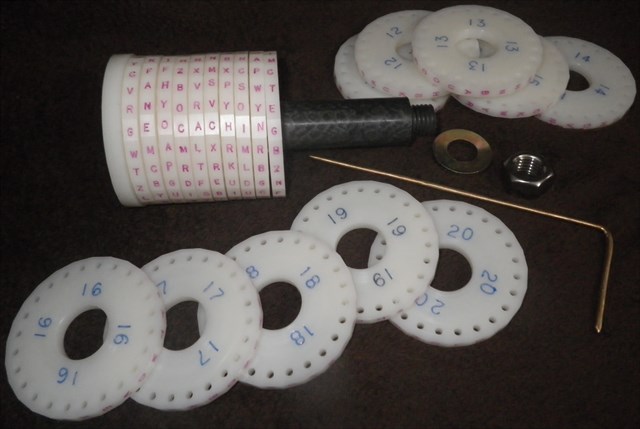Jefferson Disk Cipher Mystery Cache
-
Difficulty:
-

-
Terrain:
-

Size:  (regular)
(regular)
Related Web Page
Please note Use of geocaching.com services is subject to the terms and conditions
in our disclaimer.
A multi stage puzzle cache at Middle Creek Wildlife Management Area. This area is open to all PA hunting seasons so please wear orange during any hunting period. This is not a cache and dash. A 2-3 mile loop hike with field puzzles and multiple stages. This is an experience, not a number. Plan accordingly.
Stage 1 is at posted coordinates.

The Jefferson Disk, or Wheel, cipher was first invented in 1795 by none other than our 3rd president, Thomas Jefferson. It was re-invented in the late 1800’s by Commandant Etienne Bazeries and became more widely known as “Bazeries Cylinder”. It was upgraded and refined by the U.S. Army and used from early 1920’s until the start of WWII where it was named M-94.
It was a great but difficult way to send messages. Back in the day, before computers, the disks would have to not only be handmade but exactly the same so both the sender and receiver could code and cipher the messages. If you had a loop of 15 people sending and receiving messages between one another you needed all 15 to have exact matching disks, or wheels.
The original cipher wheel had 36 disks with each wheel having all 26 letters in the alphabet. Each wheel had a number on the side of it and the alphabet randomly printed on the outside of each disk. The disks would then be placed on an axle in a prearranged order known only to the sender and receiver/s. So the order of the disks was critical. Then the sender would spell out his message omitting punctuation and spaces and then spin the entire wheel to another row of letters and write the gibberish down to be transported to the receiver/s. The receiver would arrange his disks in the proper order and make the line of gibberish, cypher text, appear and then rotate the wheel until he could understand a message.

If the message was more than 36 letters in length you would just continue by setting the next line of cipher text. This could be done as many times as needed to get the entire message. If the message was shorter than 36 letters the blank spaces could be filled in as “x”, or any other letter, at the beginning or end just to hold space.
For the wheel you will find at stage number 1 there are a few modifications. First, 26 is a very odd number to split into 360 degrees (13.846), or a full circle. So these disks have no “J” or “Q”. You will be working with a 24 letter alphabet (15 degrees works great!). 36 wheels get very long in length and is very time consuming to make. The sample wheel is only 20 disks long.
This is a machine assisted replica. There is much handmade and no spare wheels are available. The wheels alphabet order is random, I do not know them if they go missing. If this gets lost, stolen, or damaged it will most likely be archived. Please take your time placing the disks and securing them on the center axle. The axle is threaded but made of plastic, cross threading is a very real possibility. The nut needs to be snug, not tight.
When you have the answer/s you seek, please put everything back so the next cacher can have the same experience as you did, from scratch. Marking the message on the wheels will cause a problem as there is more than one message to cipher. Shortcuts will not help the next seeker or you for the next portion of the solution.

The first stage is at the posted cords. At stage 1 are instructions to get the cords for stages 2, 3, and the final using the Jefferson Disk Wheel. You will need to locate stages 2 and 3 to get the 4-digit combination information to open the final. The stages have combination numbers only, no containers or logs. Example of what you will find at stages 2 and 3, 7X8X. That means the first and third digits to the combination for the final are 7 and 8. Stage 1 and the final are ammo cans with stages 2 and 3 being small placards, approx 2 inches by 2 inches.
This cache is meant to be an enjoyable caching experience.
Additional Hints
(No hints available.)